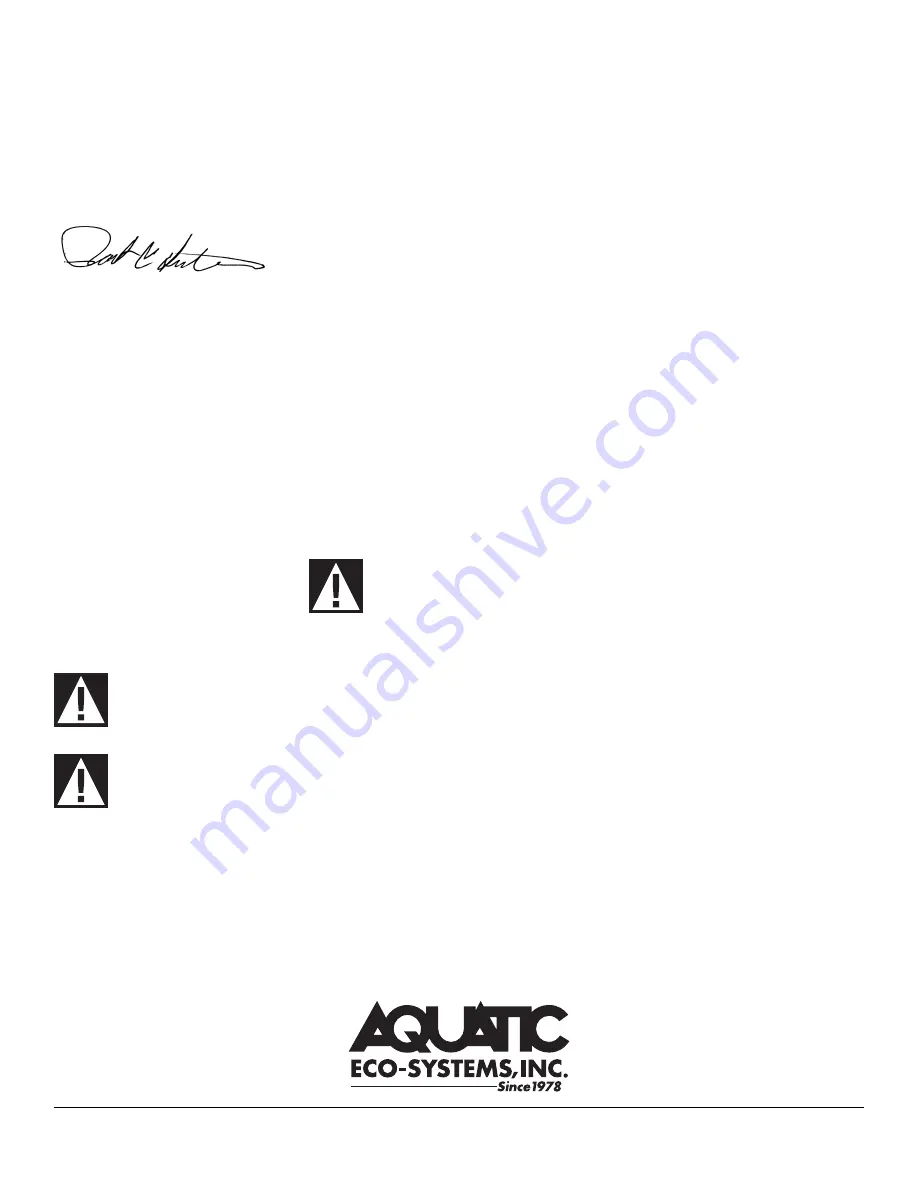
Fat Cat
™
Products Made Exclusively for Aquatic Eco-Systems, Inc. • Phone: 407-886-3939 • Fax: 407-886-6787 • aes@aquaticeco.com • aquaticeco.com
3
Dear Customer,
Thank you for your purchase of a Fat Cat™ commercial duty power
system. We believe that the Fat Cat™ name represents the finest blend
of quality, performance and price on the market.
If you need assistance setting up or operating your generator, then give
Aquatic Eco-Systems a call. AES has delivered outstanding products and
service since 1978. We have the knowledge and experience to help you
accomplish your goals.
Best regards,
Robert C. Heideman
Founder and President
AES is open from 8 a.m. to 7 p.m. Monday-Thursday,
8 a.m. to 5 p.m. Friday and 10 a.m. to 2 p.m. Saturday.
For technical help call407-886-3939.
This manual contains valuable information to help you get the best results
from your generator and provides important safety guidelines for generator
operation. Please read this manual carefully. Consider this manual a
permanent part of the generator.
Safety Messages
Safety is important to us. We have included safety messages throughout
this manual and on the generator for your protection. Please read and
follow all directions.
A safety message has a safety alert symbol
followed by an explanation of what the hazard
is, what can happen and what you should do
to avoid injury. This is the safety alert symbol:
The safety alert symbol and "WARNING" or "CAUTION" will precede
all safety messages:
WARNING
You can be killed or seriously injured if you don't follow instructions.
CAUTION
You might be injured if you don't follow instructions.
Damage Prevention Messages
A damage prevention message has "ATTENTION" with an explanation of
what the equipment hazard is and what you should do to avoid damaging
your generator:
ATTENTION
Your equipment may be damaged if you don't follow instructions.
Generator Hazards
Read and understand the information provided in this manual before
operating your generator.
Operator Responsibility
Know how to stop the generator quickly in case of an emergency.
Understand the use of all generator controls, output receptacles
and connections.
Ensure that anyone who operates the generator has proper instruction.
Do not let children operate the generator.
Carbon Monoxide Hazard
Exhaust contains poisonous carbon monoxide, a colorless and odorless
gas. Breathing exhaust may cause a loss of consciousness or even death.
Maintain adequate ventilation when operating the generator to keep a
dangerous amount of exhaust gas from building up. Do not operate in
a partially confined or enclosed area.
Electric Shock Hazard
A generator is a potential source of electrical shock that could cause
electrocution. Do not expose the generator to moisture, rain or snow.
Do not operate the generator with wet hands.
If the generator is stored outdoors and unprotected from weather,
check all electrical components on the control panel before each use.
Moisture or ice can cause a malfunction or short circuit in electrical
components, which can result in electrocution.
Do not connect the generator to a building's electrical system unless
an isolation switch has been installed by a qualified electrician.
Fire and Burn Hazards
The exhaust system gets hot enough to ignite some materials. Keep the
generator at least three feet (one meter) away from buildings and other
equipment. Do not enclose the generator in any structure. Keep flammable
materials away from the generator.
The generator's muffler becomes very hot during operation and remains
hot for some time after stopping the engine. Be careful not to touch the
muffler while it's hot. Allow the engine to cool before storing it indoors.
Gasoline is extremely flammable and is explosive under certain conditions.
Do not smoke or allow flames or sparks during refueling or where gasoline
is stored. Refuel in a well-ventilated area with the engine stopped.
Fuel vapors are extremely flammable and may ignite after the engine starts.
Wipe up any spilled fuel before starting the generator.




























